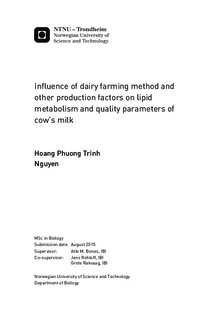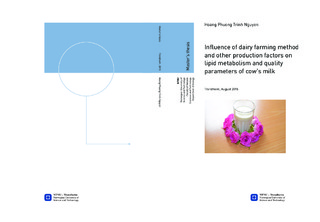| dc.description.abstract | Organic milk has been popularly developed in western dairy industry. This milk was believed to bring better health benefits than conventional milk and thus, receiving high attention from consumers in recent years. The chemical composition of organic milk versus conventional milk remains an attractive research direction in order to improve knowledge using advanced techniques such as metabolic profiling. On the other hand, milk constituents could vary with other production factors as well as processing parameters. The purpose of this study was to investigate the effects of production types together with other factors, such as season, geographical regions and fat content, on cow s milk composition, nutritional and potential sensory quality of the milk. The study included two phases of experiment. In Phase 1, organic and conventional semi-skimmed milk (1.2 1.8% fat) was collected during 5 periods from December 2012 to October 2013 from Norway, Germany, Sweden and Denmark. In Phase 2, organic and conventional whole milk (3.5 4% fat) and low fat milk (1.2 1.5% fat) were collected from June to October 2014 in Middle Norway. Lipid compounds and multi-elements were investigated in Phase 1 using ultra-performance liquid chromatography coupled with time-of-flight/mass spectrometry (UPLC-TOF-MS) and inductively coupled plasma-mass spectrometry (ICP-MS), respectively. In Phase 2, antioxidant activity and metabolites were detected and measured based on ferric reducing antioxidant power (FRAP assay) and gas chromatography-mass spectrometry (GC-MS), respectively.
The results indicated that production types had no significant influence on lipid compounds distribution, major metabolites, minerals as well as antioxidant activity. Concentration of a few metabolites (xylose, tryptophan, gluconic acid, capric acid and lauric acid) and copper (Cu) were found significantly different between organic and conventional milk. Besides, season had strong effect on distribution of lipid compounds as shown by principal component analysis (PCA). Level of major elements, except Selenium (Se), were significantly changed within a year with a remarkable drop in August. In addition, selenium level in milk was strongly affected by geographical regions. Whole milk had significantly higher antioxidant activity compared to low fat milk. Concentration of capric acid, lauric acid, palmitic acid, stearic acid, oleic acid, elaidic acid and cholesterol were significantly different between the whole and the low fat milk. Overall, the findings of this study provide a better understanding about potential factors which significantly affect milk composition and nutritional quality. | |

